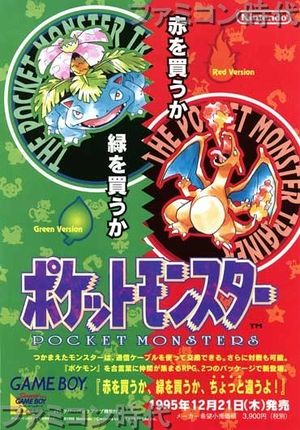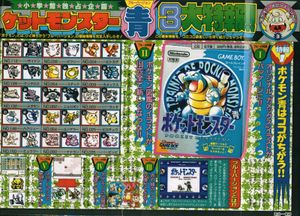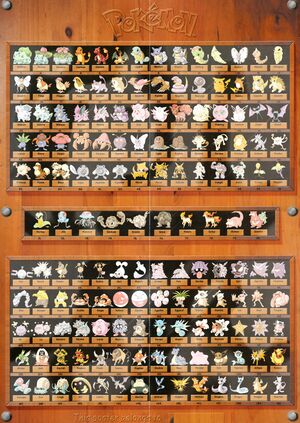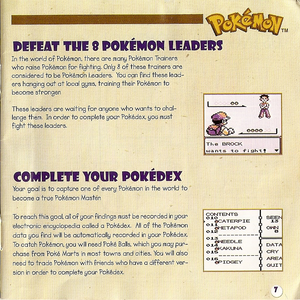Pokémon Red and Green beta

|
It has been suggested that this article be moved to Development leftovers of Pokémon Red, Green and Blue. Please discuss whether or not to move it on its talk page. |

|
This article is incomplete. Please feel free to edit this article to add missing information and complete it. |
This article lists the development leftovers and unused content of the Japanese and English Generation I games Pokémon Red and Green, Pokémon Blue, and Pokémon Red and Blue that have been documented by fans.
Global information
Pre-release
No Mew present
According to the interview by Satoru Iwata with Tsunekazu Ishihara and Shigeki Morimoto about the release of Pokémon HeartGold and SoulSilver, localized as Iwata Asks, they admitted that after the debugging tools were removed, they added Mew in the remaining space on the ROM. Nintendo thought that this would have been risky because altering the internal data after completing the testing period meant that any new bugs and/or glitches created by adding data without recurring to debugging tools would have been much harder to fix. Standard programming practices usually discourage altering the source code and not testing it just before releasing the software to the customer.[1]
Poké Balls
- Main article: Poké Ball
Some concept art depicts Poké Balls on the ground, in two pieces. This is most likely just a carryover from when Pokémon was still the concept of Capsule Monsters. Strangely, the original Poké Ball sprites from Pokémon Red and Green lack the button in the center of the Poké Ball.
Rebattling Trainers
In an interview with Shōko Nakagawa in her book Shōko Nakagawa: Pokémon Taught Me The Meaning of Life, Tsunekazu Ishihara revealed that originally, the game was programmed to trigger a battle with each Trainer any time the player walked by them, regardless if the player had already defeated them in battle previously. The wild Pokémon encounter rate was also significantly higher originally. The Trainer rebattling was omitted from the final release and the wild Pokémon encounter rate was significantly reduced.[2]
Release date
The games were originally scheduled for a December 21, 1995 release, according to an old Nintendo of Japan flyer.[3] This could explain the copyright year of 1995 that appears in the games' introductory sequence, and all subsequent games and official merchandise.
Prerelease border
On page 153 of the December 1995 book New Game Design by Game Freak is a summary of Red and Green's final plot. Two screenshots of the game are shown which use an unseen border resembling a Super Game Boy border. In it, "POCKET MONSTERS!" is written in a different size. The border has more Pokémon on it than the Super Game Boy borders from the final game. Clefairy and Pidgey are included, suggesting the screenshot may be from Japanese Red. Kangaskhan does not appear in the border.
Post-release
Concept art
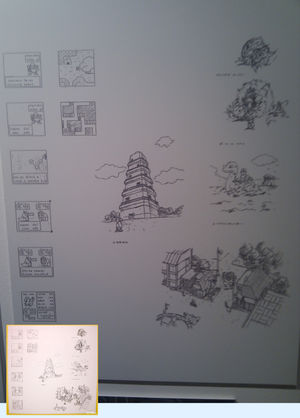
During a gaming exhibition called Game On, early concept art of Capsule Monsters by Ken Sugimori was featured, along with pre-release material from Pokémon Ruby and Sapphire. The concept art depicts rough versions of various concepts that made it into the final releases of the Generation I games. They seem to include various battles, the Safari Zone, Red riding on a Lapras, a Blastoise, Celadon City, Silph Co., and a town with a fountain which could have been reworked into Celadon City. Some other Pokémon are identifiable in a raw or semi-normal form, such as Gastly, and others are prototypical of an entire class of Pokémon, such as a basic Dragon-type.
GameCenter CX

|
This section is incomplete. Please feel free to edit this section to add missing information and complete it. Reason: Expand based on the information provided by Satoshi Tajiri, if applicable |
A Japan-exclusive special Pokémon episode of GameCenter CX, known as Retro Game Master outside of Japan, included an interview with Satoshi Tajiri, where he revealed early Pokémon character profiles of Nidoking, Slowbro and Kadabra. Notably, they are given a National Pokédex number which matches their internal index number, rather than their final Kanto Pokédex number. Nidoking, for instance is noted as being #007, rather than #034, either suggesting that there was another method of ordering the Pokémon proposed, or that they reflect their ordering in the internal data. The latter is supported by interviews with Ken Sugimori, which verify that Rhydon, which has an index number of 001, was the first Pokémon ever created, and early sketches from Capsule Monsters featuring Rhydon. Nidoking is also referred to as マイコー♂ Maikō♂, indicating that there were either placeholder or alternate names for Pokémon before the development of Pokémon Red and Green had finished.
Professor Oak battle
- Main article: Unused Trainer data →Prof. Oak

Unused Trainer data for Prof. Oak (Japanese: オーキドせんせい Teacher Oak) exists in all Generation I games.
Prof. Oak has data for three different teams using different first partner Pokémon, with each Pokémon being lv66-70, higher than Blue's Champion battle team. It is possible he was meant to be a late-game opponent, perhaps similar to Red in Generation II.
He can be battled by exploiting certain glitches.
Bird type
- Main article: List of glitch types in Generation I
The Bird type may have been a prototype for the Flying type. This can be seen in the final releases: MissingNo. is recognized as a dual-type Bird/Normal Pokémon. The Bird type is present in the internal data of the Generation II games, possibly due to their engine being an upgraded version of that of the Generation I games.
Directions
Unused text strings within the game show option dialogs for North/West (Japanese: きた/にし North/West), North/East (Japanese: きた/ひがし North/East), and South/East (Japanese: みなみ/ひがし South/East). These do not appear in the final release, with the only in-game option dialogs being Yes/No (Japanese: はい/いいえ Yes/No) and Heal/Cancel (Japanese: あずける/やめる Heal/Cancel).[4][5] (For unknown reasons, there is no unused South/West (Japanese: みなみ/にし South/West) option dialog.)
Unused Trainer class
- Main article: Glitch Trainer
A Trainer class known as Chief (Japanese: シルフのチーフ Silph's Chief) was omitted from the final releases, though like Professor Oak, a battle with an NPC with this data can be accessed through modification of the internal data or saved game data as well by cheating. It is apparently mentioned in-game by one of the Team Rocket Grunts in Celadon City, and shares its battle sprite with the Scientist Trainer class since its index number of 0xE3 precedes it (Scientist's is 0xE4). He has no defined roster, instead using the one for the first Scientist on the internal list. Also like Professor Oak, he has no preset dialogues programmed in either for before the battle or after defeating him.[5]
Its Japanese name suggests that the President of Silph Co. was originally planned as a Trainer that could be challenged to battle.
Unused Trainer actions
There is unused data within the games for trainers to use various items that goes unused.[6]
Extra field move
An extra field move might have been planned as there is an unused entry between Fly and Surf within the internal data. It could also have been an HM as it is placed between the aforementioned HM02 and HM03 and all HMs are ordered by number in the internal data. Given its index number of 0xB4 and that the highest index number used for actual moves is 0xA5, other moves beyond the 165 introduced in Generation I were once planned as well.[5]
The unused text string "Ground rose up somewhere!" (Japanese: どこかでじめんがもりあがった!) might be related to this scrapped field move.[7]
Music
An unused track has been discovered in the internal data. The music is originally high-pitched and incomplete as only the individual audio channels are left. There have also been attempts at recreating what the full theme would sound like.
- Original music
| |
| This video is not available on Bulbapedia; instead, you can watch the video on YouTube here. | |
| |
| This video is not available on Bulbapedia; instead, you can watch the video on YouTube here. | |
- Recreation attempt
| |
| This video is not available on Bulbapedia; instead, you can watch the video on YouTube here. | |
Locations
- Main article: List of locations by index number in Generation I
There are three map locations which are each identical to another map used in the final releases, except for the fact that the default theme used in the alternative location is different.[8]
- The house invaded by Team Rocket in Cerulean City: has index number
0x45instead of0x3Eand plays Caves of Mt. Moon - The Underground Path's entrance at Route 6: has index number
0x4Binstead of0x4Aand plays Vermilion City Theme - The Poké Mart at Cinnabar Island: has index number
0xADinstead of0xACand plays Cinnabar Island Theme
In addition, 25 deleted map locations with leftover header data are present in the internal list of location index numbers.
- Three use the Victory Road map header (index numbers
0x69-0x6B) - 17 use the Pokémon League map header (index numbers
0x6D-0x70,0x71-0x75and0xED-0xF4) - One uses the Pokémon Tower map header (index number
0x94). - Three use the Rocket Hideout map header (index numbers
0xCC-0xCE). - Another uses the Rock Tunnel map header (index number
0xE7).
Formatted data exists for an additional map location.[9] It is located straight after the final town in memory (Saffron City) but just before Route 1. Its associated data is completely blank, even its header data and coordinates on the Town Map (as it is set as being part of Pallet Town, with coordinates (0,0)), except for the fact that an unused flag when checked allows the player to Fly to it. Attempting to travel to this location simply freezes the games.
There is an unused warp tile in Celadon City.[10] It is internally programmed in to lead to 5F of Celadon Dept. Store, which in turn has its internal data located away from the data for the other floors, possibly suggesting that it was originally a completely different map in earlier stages of development, which is supported by the aforementioned discovery.
| |
| This video is not available on Bulbapedia; instead, you can watch the video on YouTube here. | |
A part of the internal data relates to a Poké Mart placed between the data for the Fuchsia and Cinnabar Poké Marts and may be associated with the formatted map location as mentioned above. The item list contains Great Balls, Super Potions, Hyper Potions, Full Heals and Revives.
Items
- Main article: List of unobtainable items
Regularly unobtainable Key Items with the names of all the Badges exist in the internal data (index numbers 0x15-0x1C). This could mean that the Badges were originally going to be items that were carried in the player's Bag; however, as Key Items, they appear to be actually used in the list of Badges presented by the Gym Badge man in Cerulean City.[11] The BoulderBadge (index number 0x15) and CascadeBadge (index number 0x16) are the only ones that do something when used in battle—they allow the player to throw Bait and Rocks, respectively, as in the Safari Zone battles. When used in the overworld (except dungeons and caves), it changes the background music to a single channel of 道案内 Guidance; if used in a dungeon or cave, it changes the background music to a single channel of ~オープニング~ ~Opening~. This is due to the function that plays the "throw Bait or Rock" sound effect attempting to load it but referring to the wrong soundbank.
Key Item ????? (index number 0x07) enables the player to Surf without using a Pokémon. Badges are not required either. Due to this ability, it is often referred to as Surfboard. In the final releases, the move Surf can be used by a Pokémon as a field move serving the same function. It may indicate that Surf was not originally implemented as a field move or that this is a debugging item used by the programmers. Unlike the move Surf, it also allows surfing on Route 17's Cycling Road and does not trigger the "Cycling is fun! Forget Surfing!" (Japanese: せっかくのサイクリング!⋯⋯なみのりはやめとこう) message.
The Pokédex is also present as a Key Item with index number 0x09 and can be accessed during battle, much like Ash does in Pokémon the Series. It also causes the VRAM to load the overworld tileset and turns the HP bar to letters when used in battle.
Coin is programmed in as regular inventory item, having index number 0x3B. It cannot be used for slot machines or price exchanges, rendering it completely unusable. It will stack if multiple Coins are obtained; however, it is not stored by the Coin Case. It can be sold for $5 each at any Poké Mart and bought for $10 each from a Poké Mart with a modified item list. Actual Coin Case-stored Coins are available for double the price, at $20 per Coin, and cannot be sold. In the Trainer's Guide (manual) of Pokémon Red and Blue, it is listed as a "miscellaneous item"; thus, it is the only item to be included in this category.[12]
TMs 51-55 (index numbers 0xFB-0xFF) were planned and contain each HM's respective field move by order. They stack as any other TM and can be sold at Poké Marts.[5]
- TM51 teaches Cut like HM01; can be sold for $1500 and bought for $3000
- TM52 teaches Fly like HM02; can be sold for $7000 and bought for $14000
- TM53 teaches Surf like HM03; can be sold and/or bought for $0
- TM54 teaches Strength like HM04; can be sold for $4000 and bought for $8000
- TM55 teaches Flash like HM05; can be sold for $2000 and bought for $4000. Also appears as Cancel (Japanese: やめる Cancel) and hides items below it; this secondary effect might be due to its index number (
0xFF), which puts it at the bottom of the item list in the internal data.
Another Key Item named ????? (index number 0x2C) and a fake PP Up (index number 0x32) exist and are completely useless. The fake PP Up can be sold for $4900 and bought for $9800, unlike the real PP Up, which is sold and/or bought for $0.
Sprites
Different front sprites of Pokémon were planned for Pokémon Blue, notably the ones for Raticate, Rhydon, Ditto, Dragonair and Mewtwo. These were featured in the November 1996 issue of CoroCoro Comic, which published general information about the game.[13]
Cries
Certain MissingNo. use specific leftover cries.[5][14]
- Cries with index numbers
0x43(Base 0, Pitch 128, Length 16),0x45(Base 29, Pitch 244, Length 64), and0x4F(Base 34, Pitch 255, Length 64) do not appear to resemble the cry of any actual Pokémon. - Cry with index number
0x51(Base 14, Pitch 224, Length 96) resembles Pidgey's cry, cries0x5E(Base 15, Pitch 64, Length 192) and0x89(Base 15, Pitch 64, Length 128) resemble Dragonair's; cry0x5F(Base 15, Pitch 32, Length 192) resembles Venusaur's and cry0x7F(Base 17, Pitch 32, Length 16) resembles either Vaporeon's, Jolteon's or Flareon's cries. - Cry with index number
0xB5(Base 29, Pitch 0, Length 128) is modified from Zubat's but resembles Crobat's, suggesting that the Pokémon might have been originally planned for Generation I instead of Generation II.
| |
| This video is not available on Bulbapedia; instead, you can watch the video on YouTube here. | |
Text
- Main article: List of items by index number in Generation I
Unused text strings referring to Badges and titles exist in the Japanese versions, but were not translated for the localizations. The katakana used for the gairaigo (loanword) of "badge" is also slightly different, being バッヂ Baddji instead of バッジ Bajji.[5] These names appear in the internal item list of the Japanese versions on offsets 0x4A92-0x4B08, which would suggest that they are items; however, they do not have valid effects if they are forcedly used as items. The most likely scenario is that these names originally belonged to different multiple lists.
- かみなりバッヂ Lightning Badge
- Not to be confused with the Thunder Badge, which is named オレンジバッジ Orange Badge in Japanese.
- かいがらバッヂ Shell Badge
- おじぞうバッヂ Jizo Badge
- A possible reference to the Japanese variation of Ksitigarbha, known as Jizo.
- はやぶさバッヂ Falcon Badge
- ひんやりバッヂ Cool Badge
- なかよしバッヂ Friendship Badge
- バラバッヂ Rose Badge
- ひのたまバッヂ Fireball Badge
- ゴールドバッヂ Gold Badge
- ゴールドバッジ Gold Badge is actually the Japanese name of the Marsh Badge.
- たまご Egg
- ひよこ Chick
- ブロンズ Bronze
- シルバー Silver
- ゴールド Gold
- プチキャプテン Little Captain
- キャプテン Captain
- プチマスタ Little Master
- マスター Master
Default player and rival names
The unused default name for Red in the English versions is Ninten while Blue's is Sony. While it is impossible to view these names during regular gameplay, changing a few memory addresses in RAM can allow for these names to appear as shown here. This references the fact that in the years surrounding the releases of the Generation I games, Sony was Nintendo's main competition. Ninten is also the default name of the main protagonist of Mother, a game developed by Creatures, Inc., which has worked on the Pokémon games since the start.
In the Japanese versions, the unused default names for Red and Blue differ between Pokémon Red and Green and Pokémon Blue:[15]
- In Pokémon Red and Green, Red's unused default name is やまぐち Yamaguchi while Blue's is いしはら Ishihara. Yamaguchi refers to Wataru Yamaguchi, an art director that worked on the original games, while Ishihara refers to Tsunekazu Ishihara, the current president and CEO of The Pokémon Company and who was the games' producer at the time.
- In Pokémon Blue, the unused default names for Red and Blue are, respectively, ゲーフリ Gēfuri, an abbreviation of Game Freak's name in Japanese (ゲームフリーク Gēmu Furīku), and クリチャ Kuricha, a reference to Creatures, Inc.
Unused in-game trade
- Main article: In-game trade
A Butterfree-for-Beedrill in-game trade was originally planned.[16] The Beedrill's nickname in Pokémon Red and Green is ピピん Pipin and チクチク Chikuchiku in Pokémon Blue. This explains why the international releases contain unused text strings referring to a Beedrill nicknamed Chikuchiku.
Unused coding leftover in the game shows that three specific house maps (DF, E0, and E1) contain data for Pokémon Center PCs in the same location PCs would be located in a Pokémon Center. Teleport checks where the last location of a Pokémon Center was and if it sees that it was a Safari Zone rest house, will not teleport you to that location. The invisible PC data was later removed in Pokémon Yellow releases.[17]
Unobtainable Nugget in Safari Zone entrance
If the Itemfinder is used at the Safari Zone entrance, it will say an item is nearby but it cannot be obtained without cheating.
Unused Elite Four walking sprites
There is sprites for the four members of the Elite Four walking but as they all stand still, the sprites never get to be seen.[18]
Super-effective Dragon type
The Dragon type is super effective against itself in Generation I. However, due to the only Dragon-type move, Dragon Rage, always dealing exactly 40 damage, this behavior never gets to be seen.
Unused move effects
There are unused effects for moves, the only effect to go used is 23 as the effect was assigned to Blizzard in the original Pokémon Red and Green.
Unused Trainer partiesThere are a number of Trainers with teams that are never referred to or called on in the game data that are leftover.[19]
|
